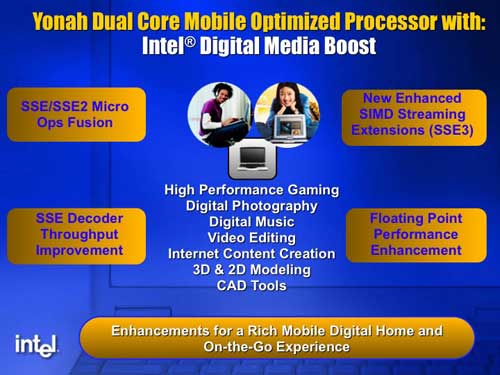Intel Yonah Performance Preview - Part I: The Exclusive First Look at Yonah
by Anand Lal Shimpi on November 30, 2005 2:50 AM EST- Posted in
- CPUs
Same Size, but Twice the Cores
Obviously the biggest improvement Yonah offers over Dothan is the fact that it’s dual core. But where things get interesting is that thanks to Yonah’s 65nm process, a dual core Yonah die is about the same size as a single core Dothan die - in other words, it costs Intel just as much to make a dual core Yonah, as it did for them to make a single core Dothan.
A major reason the die size didn’t really go up much is because although Yonah has two cores, its L2 cache size remains unchanged at 2MB. Unlike the Pentium D, Yonah’s 2MB L2 cache is not split into two discrete 1MB caches, it is actually one whole 2MB cache that is shared by both cores. This is a very important distinction, as it means that Yonah is far from just two Dothans stuck together.
There are other architectural enhancements to Yonah that will give it a performance advantage over Dothan. Below is an excerpt from our IDF coverage of Yonah, detailing what we know about the new CPU:
Making Pentium M more "Media Friendly"
All of the major performance improvements to each of Yonah's cores seem to revolve around SIMD FP and FP performance, two of the Pentium M's present day weaknesses in comparison to the Pentium 4.
The first improvement is that now all three of Yonah's decoders can decode SSE instructions, regardless of the type of instruction. Improving the decode width of the processor is a quick way to improve performance.
Next, SSE/SSE2 operations (not sure if all can be, but at least some) can now be fused using the Micro Ops Fusion engine of Yonah. At a high level, the benefit here is increased performance and lower power consumption, we'll get into architectural details of why that is when we eventually sink our teeth into Yonah next year.
Each of the two cores in Yonah have also received support for SSE3 instructions much like the Pentium 4 E [Prescott].
And finally there have been some improvements to Yonah's floating point performance, although Mooly would not say exactly what's been done. Curiously, Mooly referred to the floating point performance improvements as specifically made to improve gaming performance. Intel may have grander plans for Yonah than once thought...
The SSE/FP optimizations are all being grouped into what Intel is calling their Digital Media Boost technology, yes the names seem to get worse and worse as time goes on - but at least the functionality should be good.
We started out this article talking about the Pentium M’s shortcomings in digital media applications, and Intel has begun to address them with the architecture of Yonah, but the real question is - how effective have their efforts been?











135 Comments
View All Comments
monsoon - Wednesday, November 30, 2005 - link
i am waiting for overclocking tests and most of all the coming release of a MAC MINI with this baby inside. I'm going to run windows on it if possible ( so does it come with VT or not ? ). Hopefully january won't be a let down from apple...tfranzese - Wednesday, November 30, 2005 - link
Are you dense?Ask yourself: What's the mini's price point? Now, what do you think this chip's price point will be?
I think you're dreaming.
Furen - Wednesday, November 30, 2005 - link
I wouldnt quite put it like that. I think single-core Yonahs will find themselves thrown into the cheaper Mac Minis, I dunno if apple will actually make a premium version with the dual-core CPUs.forPPP - Wednesday, November 30, 2005 - link
I don't understand all those comments that AMD is 2 year ahead because Athlon 64 X2 3800+ is on average 8% faster.Yohan is MOBILE cpu, while Athlon 64 X2 is desktop. Please compare Yohan with Turion and then complain.
Intel has lead with 65 nm technology which means AMD won't catch it up for very long in mobile market. Turion dual core at 90 nm will be far far behind Yohan.
rpsgc - Wednesday, November 30, 2005 - link
Yonah is a 65nm dual-core, Turion is a 90nm single-core....
forPPP - Wednesday, November 30, 2005 - link
[quote]Yonah is a 65nm dual-core, Turion is a 90nm single-core....[/quote]And that's why for now there is nothing to compare. Yonah is its in own class. Even "Turion Dual Core" will be behind it, because of power consumption problem.
tfranzese - Wednesday, November 30, 2005 - link
Really? I can't pick a notebook up today that has one, so comparing a processor that's been shipping for quite some time to this one means little.
Further, no one seems to point it out, but does Yonah not have 64-bit extensions? If not, now that near every desktop CPU sold today has them it'd be a real shame if 64-bit Windows development gained momentum.
forPPP - Wednesday, November 30, 2005 - link
Great point. You are right. It's the biggest disadvantage of the Yonah.
Viditor - Wednesday, November 30, 2005 - link
WHAT power consumption problem?
Shintai - Wednesday, November 30, 2005 - link
Maybe the power problem with adding over twice the transistors.Dothan->Yonah ~140mio to ~151mio ~8% more transistors
Turion->Turion X2 ~105mio to ~233mio(X2 current) ~121% more transistors.
And transistors = powerusage.